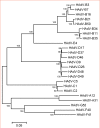Unique sequence features of the Human adenovirus 31 complete genomic sequence are conserved in clinical isolates
- PMID: 19939241
- PMCID: PMC2794291
- DOI: 10.1186/1471-2164-10-557
Unique sequence features of the Human adenovirus 31 complete genomic sequence are conserved in clinical isolates
Abstract
Background: Human adenoviruses (HAdV) are causing a broad spectrum of diseases. One of the most severe forms of adenovirus infection is a disseminated disease resulting in significant morbidity and mortality. Several reports in recent years have identified HAdV-31 from species A (HAdV-A31) as a cause of disseminated disease in children following haematopoetic stem cell transplantation (hSCT) and liver transplantation. We sequenced and analyzed the complete genome of the HAdV-A31 prototype strain to uncover unique sequence motifs associated with its high virulence. Moreover, we sequenced coding regions known to be essential for tropism and virulence (early transcription units E1A, E3, E4, the fiber knob and the penton base) of HAdV-A31 clinical isolates from patients with disseminated disease.
Results: The genome size of HAdV-A31 is 33763 base pairs (bp) in length with a GC content of 46.36%. Nucleotide alignment to the closely related HAdV-A12 revealed an overall homology of 84.2%. The genome organization into early, intermediate and late regions is similar to HAdV-A12. Sequence analysis of the prototype strain showed unique sequence features such as an immunoglobulin-like domain in the species A specific gene product E3 CR1 beta and a potentially integrin binding RGD motif in the C-terminal region of the protein IX. These features were conserved in all analyzed clinical isolates. Overall, amino acid sequences of clinical isolates were highly conserved compared to the prototype (99.2 to 100%), but a synonymous/non synonymous ratio (S/N) of 2.36 in E3 CR1 beta suggested positive selection.
Conclusion: Unique sequence features of HAdV-A31 may enhance its ability to escape the host's immune surveillance and may facilitate a promiscuous tropism for various tissues. Moderate evolution of clinical isolates did not indicate the emergence of new HAdV-A31 subtypes in the recent years.
Figures





Similar articles
-
A Prolonged Outbreak of Human Adenovirus A31 (HAdV-A31) Infection on a Pediatric Hematopoietic Stem Cell Transplantation Ward with Whole Genome Sequencing Evidence of International Linkages.J Clin Microbiol. 2022 Nov 16;60(11):e0066522. doi: 10.1128/jcm.00665-22. Epub 2022 Oct 12. J Clin Microbiol. 2022. PMID: 36222515 Free PMC article.
-
Genomic characterization of a novel human adenovirus type 31 recombinant in the hexon gene.J Gen Virol. 2011 Dec;92(Pt 12):2770-2775. doi: 10.1099/vir.0.034744-0. Epub 2011 Aug 31. J Gen Virol. 2011. PMID: 21880842
-
Genomic and bioinformatics analysis of human adenovirus type 37: new insights into corneal tropism.BMC Genomics. 2008 May 9;9:213. doi: 10.1186/1471-2164-9-213. BMC Genomics. 2008. PMID: 18471294 Free PMC article.
-
Phylogenetic analysis and structural predictions of human adenovirus penton proteins as a basis for tissue-specific adenovirus vector design.J Virol. 2007 Aug;81(15):8270-81. doi: 10.1128/JVI.00048-07. Epub 2007 May 23. J Virol. 2007. PMID: 17522221 Free PMC article.
-
High genetic stability of co-circulating human adenovirus type 31 lineages over 59 years.Virus Evol. 2022 Aug 4;8(2):veac067. doi: 10.1093/ve/veac067. eCollection 2022. Virus Evol. 2022. PMID: 36533152 Free PMC article.
Cited by
-
Computational analysis of human adenovirus serotype 18.Virology. 2010 Sep 1;404(2):284-92. doi: 10.1016/j.virol.2010.05.013. Epub 2010 Jun 9. Virology. 2010. PMID: 20542532 Free PMC article.
-
Genomic foundations of evolution and ocular pathogenesis in human adenovirus species D.FEBS Lett. 2019 Dec;593(24):3583-3608. doi: 10.1002/1873-3468.13693. Epub 2019 Dec 11. FEBS Lett. 2019. PMID: 31769017 Free PMC article. Review.
-
A Prolonged Outbreak of Human Adenovirus A31 (HAdV-A31) Infection on a Pediatric Hematopoietic Stem Cell Transplantation Ward with Whole Genome Sequencing Evidence of International Linkages.J Clin Microbiol. 2022 Nov 16;60(11):e0066522. doi: 10.1128/jcm.00665-22. Epub 2022 Oct 12. J Clin Microbiol. 2022. PMID: 36222515 Free PMC article.
-
Adenoviromics: Mining the Human Adenovirus Species D Genome.Front Microbiol. 2018 Sep 11;9:2178. doi: 10.3389/fmicb.2018.02178. eCollection 2018. Front Microbiol. 2018. PMID: 30254627 Free PMC article. Review.
-
Perspective on Adenoviruses: Epidemiology, Pathogenicity, and Gene Therapy.Biomedicines. 2019 Aug 19;7(3):61. doi: 10.3390/biomedicines7030061. Biomedicines. 2019. PMID: 31430920 Free PMC article. Review.
References
-
- Swenson PD, Wadell G, Allard A, Hierholzer JC. In: Manual of Clinical Microbiology. Murray PR, Baron EJ, Pfaller MA, Jorgensen JH, Yolken RA, editor. Vol. 2. Washington, D.C.: ASM Press; 2003. Adenoviruses; pp. 1404–1417.
-
- Benkö M, Harrach B, Russell WC. Virus taxonomy Seventh report of the international Commitee on Taxonomy of Viruses. New York, N.Y.: Academic Press; 2000. Adenoviridea.
-
- Shenk T. Adenoviridae: The viruses and their replication. New York: Lippincott-Raven publishers; 2001.
MeSH terms
Substances
LinkOut - more resources
Full Text Sources
Other Literature Sources
Miscellaneous

